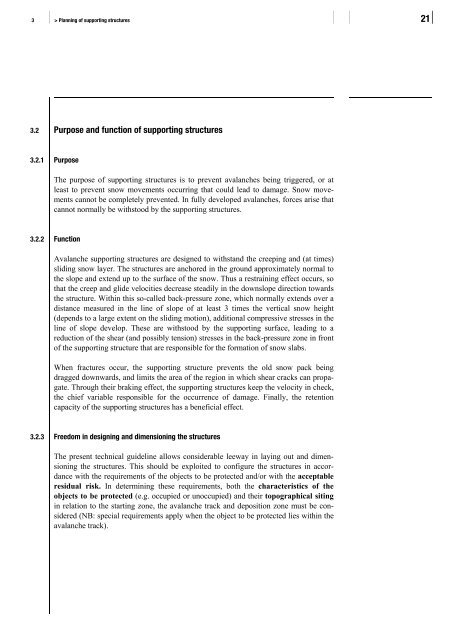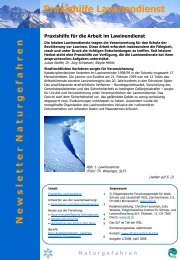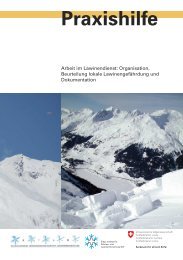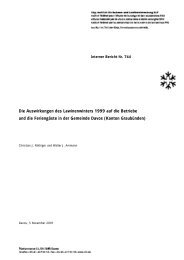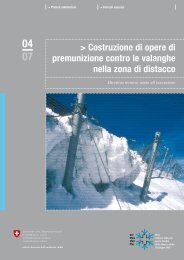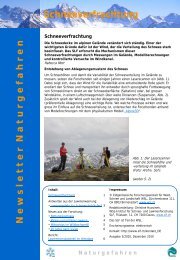Defense structures in avalanche starting zones - SLF
Defense structures in avalanche starting zones - SLF
Defense structures in avalanche starting zones - SLF
Create successful ePaper yourself
Turn your PDF publications into a flip-book with our unique Google optimized e-Paper software.
3 > Plann<strong>in</strong>g of support<strong>in</strong>g <strong>structures</strong> 21<br />
3.2 Purpose and function of support<strong>in</strong>g <strong>structures</strong><br />
3.2.1 Purpose<br />
The purpose of support<strong>in</strong>g <strong>structures</strong> is to prevent <strong>avalanche</strong>s be<strong>in</strong>g triggered, or at<br />
least to prevent snow movements occurr<strong>in</strong>g that could lead to damage. Snow movements<br />
cannot be completely prevented. In fully developed <strong>avalanche</strong>s, forces arise that<br />
cannot normally be withstood by the support<strong>in</strong>g <strong>structures</strong>.<br />
3.2.2 Function<br />
Avalanche support<strong>in</strong>g <strong>structures</strong> are designed to withstand the creep<strong>in</strong>g and (at times)<br />
slid<strong>in</strong>g snow layer. The <strong>structures</strong> are anchored <strong>in</strong> the ground approximately normal to<br />
the slope and extend up to the surface of the snow. Thus a restra<strong>in</strong><strong>in</strong>g effect occurs, so<br />
that the creep and glide velocities decrease steadily <strong>in</strong> the downslope direction towards<br />
the structure. With<strong>in</strong> this so-called back-pressure zone, which normally extends over a<br />
distance measured <strong>in</strong> the l<strong>in</strong>e of slope of at least 3 times the vertical snow height<br />
(depends to a large extent on the slid<strong>in</strong>g motion), additional compressive stresses <strong>in</strong> the<br />
l<strong>in</strong>e of slope develop. These are withstood by the support<strong>in</strong>g surface, lead<strong>in</strong>g to a<br />
reduction of the shear (and possibly tension) stresses <strong>in</strong> the back-pressure zone <strong>in</strong> front<br />
of the support<strong>in</strong>g structure that are responsible for the formation of snow slabs.<br />
When fractures occur, the support<strong>in</strong>g structure prevents the old snow pack be<strong>in</strong>g<br />
dragged downwards, and limits the area of the region <strong>in</strong> which shear cracks can propagate.<br />
Through their brak<strong>in</strong>g effect, the support<strong>in</strong>g <strong>structures</strong> keep the velocity <strong>in</strong> check,<br />
the chief variable responsible for the occurrence of damage. F<strong>in</strong>ally, the retention<br />
capacity of the support<strong>in</strong>g <strong>structures</strong> has a beneficial effect.<br />
3.2.3 Freedom <strong>in</strong> design<strong>in</strong>g and dimension<strong>in</strong>g the <strong>structures</strong><br />
The present technical guidel<strong>in</strong>e allows considerable leeway <strong>in</strong> lay<strong>in</strong>g out and dimension<strong>in</strong>g<br />
the <strong>structures</strong>. This should be exploited to configure the <strong>structures</strong> <strong>in</strong> accordance<br />
with the requirements of the objects to be protected and/or with the acceptable<br />
residual risk. In determ<strong>in</strong><strong>in</strong>g these requirements, both the characteristics of the<br />
objects to be protected (e.g. occupied or unoccupied) and their topographical sit<strong>in</strong>g<br />
<strong>in</strong> relation to the start<strong>in</strong>g zone, the <strong>avalanche</strong> track and deposition zone must be considered<br />
(NB: special requirements apply when the object to be protected lies with<strong>in</strong> the<br />
<strong>avalanche</strong> track).


